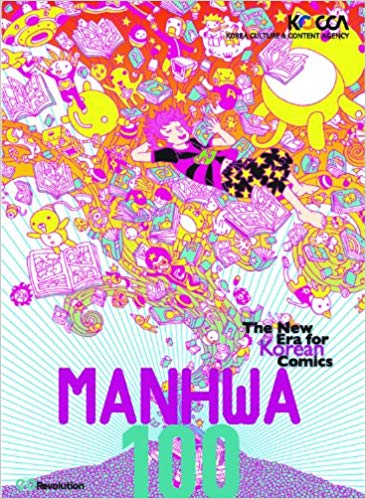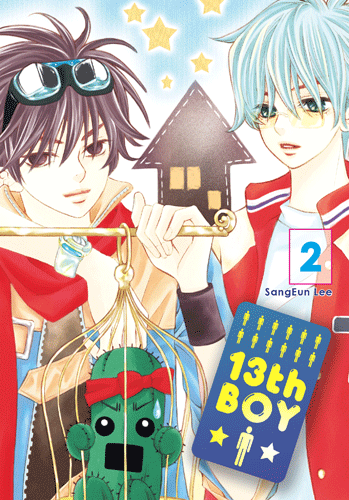As a reviewer, I’ve found Manga: The Complete Guide (Del Rey), Dreamland Japan: Writings on Modern Manga (Stonebridge Press), and Manga: 60 Years of Japanese Comics (Laurence King Publishing) indispensable references, whether I’m searching for information about a series’ publication history or looking for insight into a particular artist’s style. I hoped that Manhwa 100: The New Era for Korean Comics would provide a similar perspective on the Korean comics industry. Unfortunately, Manhwa 100 turned out to be an ambitious but poorly executed attempt to highlight the medium’s most popular, influential series.
In terms of organization and metholodgy, Manhwa 100 falls somewhere between Manga: The Complete Guide and Dreamland Japan, offering summaries of one hundred books, some of which have been translated into English. Each entry includes basic information about the series’ print run (e.g. number of volumes, magazine of serialization), its author, and its crossover into other media (e.g. videogames, television programs), as well as a plot summary and an assessment of the work’s artistic merit. Entries are grouped according to audience, with sections devoted to sunjeong (girls’) comics, boys’ comics, adult comics, and “webtoons,” comics that debuted online but were later anthologized in print.
We learn in the introduction that a committee of thirty industry professionals chose the books featured in Manhwa 100. The exact selection criteria are never satisfactorily explained, though it’s obvious the committee made a concerted effort to represent a broad spectrum of styles and subjects; no artist has more than one entry devoted to her work. Most books are of recent vintage, with only a smattering of titles released in the 1970s and 1980s.
And here I have a confession to make: I was sorely tempted to call my review “Manhwa 100: Cultural Learnings of Comics for Make Benefit Glorious Nation of Korea.” Why? The text is awash in awkward phrases, grammatical errors, egregious typos, and ill-advised attempts to keep it real with slangy, conversational phrases that clash violently with the prevailing tone. The entry for Blue, a title by Lee Eun-hye, is typical of the book:
Comic book characters are used in many character merchandises now, but it was [sic] not very actively used in the 1990s. However, the comics of Lee Eun-hye were widely used in character merchandises, even in the 1990s. This is because the author has the knack of using colors as one of her main themes. As she said in her own words, “color in itself is a story.”
As she proclaims in Jump Tree A+, her previous work to Blue, the teenage years are the “Green Age.” Her new story, Blue, represents the young adult age. The color blue in the comic has two sides. It represents a bright fresh side of youth, and it also represents sadness and gloom. The twenty-somethings in the comic are both fresh and youthful, but at the same time lonely and nostalgic.
A rich man’s illigitemate [sic] son Seung-pyo, passionate dancer Hae-joon, his faithful follower Yeon-woo, smart but cold Hyun-bin, and strong charismatic rocker Ha-yun: Blue revolves around these five characters. The loneliness in Blue was sprouted from self-pity and narcissism. Like in many of her other comics, author Lee Eun-hye pushes her characters into their own narcissistic world disconnected from each other.
That is why Blue is beautiful. The earnest characters express their life honestly. And the poetic narration and symbolic monologues add to its beauty. In 1997, an OST disc, inspired by the comic, was…
Yes, the entry really does end with an incomplete sentence.
If I’m reading the text correctly, this confusing verbiage could be boiled down to three talking points: (1) Lee’s manhwa was among the first to inspire “character goods” (phone cards, figurines, stationery, keychains, etc.); (2) her books feature beautifully drawn, emotionally stunted characters; and (3) her books are popular enough to be adapted into TV shows, CD dramas, and the like. Though it’s obvious she views color as a metaphor for age and mood, it’s not clear how or if she uses color in her work–a crucial point, given the increasingly important role that color is beginning to play in manhwa. It’s also unclear what distinguishes Lee’s work from other sunjeong titles, as symbolism, emotionally-charged conversation, and interior monologues are staples of the medium, not personal idiosyncrasies.
If the book synopses are frustrating, the contextual essays are downright obtuse. With titles such as “Open a Manhwa Book, Become a Friend of Korea” and “Manhwa in America: The New World of Charms Yet to be Discovered,” their stilted language and boastful claims for manhwa’s international importance make them sound like Pravda articles. Anyone hoping for insight into the differences between manhwa and manga (or other sequential art traditions, for that matter) will be frustrated by the maddeningly vague, jingoistic text which acknowledges stylistic similarities between manhwa and manga while arguing for significant differences in subject and approach. As manhwaga Lee Hyun-se explains:
While the Japanese samurai pulls out his sword for the completion of his skill, the Korean warrior draws his sword in revenge of his family or to fight against his or her sworn enemy. The Japanese hero walks the glorified path of the hero, which is as clear as the blood he spills, but the Korean hero trudges, stumbling upon his own defects.
Lee attributes the difference in approach to Korea’s lengthy history of occupation, contrasting it with Japan’s long period of isolationism and political intrigue. “The endless internal strife of the Japanese builds up a sense of hubris and elitism,” he argues, “while being on the defense instills a sense of humility and compassion for others… The hero of Japanese manga is ‘I’ while the hero in Korean manhwa is ‘We.’” It’s an interesting but flawed thesis, akin to suggesting that Howard’s End and Finnegan’s Wake are utterly different because one was written by a British imperialist and the other by a downtrodden Irishman. Lee seems to forget that avenging one’s family (or village, or sweetheart, or mentor) is one of the most basic manga plotlines, transcending genre and time period. He also overlooks the important role of community in manga; for every Lone Wolf, there are just as many characters who discover their purpose when they join a particular group, whether it be the school council (a la Love Master A) or the Shinsengumi (a la Kaze Hikaru).
Given Manhwa 100‘s limitations, I’m reluctant to recommend it; anyone hoping for an indispensable reference or an introduction to Korean comics will find this book baffling. For those already enchanted with manhwa, however, I’d suggest reading Manhwa 100 in the same spirit that our grandparents and parents flipped through the Sears Roebuck catalog: as a book of possibilities, a wish list for readers who enjoyed Shaman Warrior, One Thousand and One Nights, Bride of the Water God, or Dokebi Bride. I’ve already spotted dozens of great candidates for licensing, from Be Good, a comedy about a gangster who goes back to high school at 40, to Buddy, a sports drama set inside the ultra-competitive world of women’s golf.
POSTSCRIPT, 2/3/09: I corresponded with the editorial staff at NETCOMICS, who explained that they had a contract with the Korea Culture and Content Agency (KOCCA) to distribute Manhwa 100 in North America. The book was written and produced by C&C Revolution, a private company. (No individuals are named as authors.) NETCOMICS is not responsible for the book’s editorial content, just for its distribution.
This review originally appeared at The Manga Curmudgeon on February 2, 2009.

